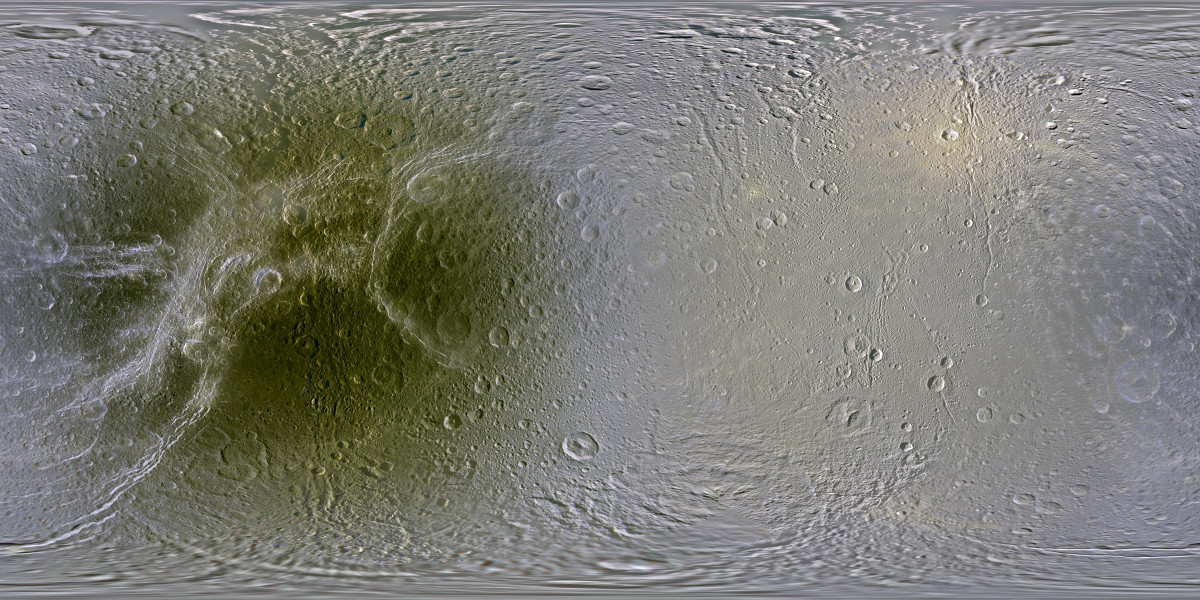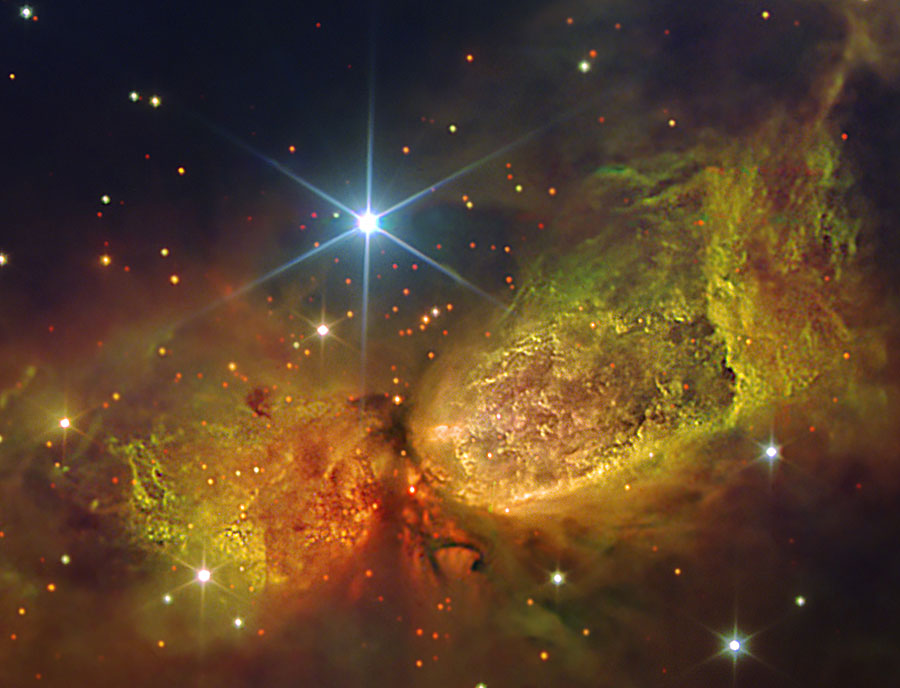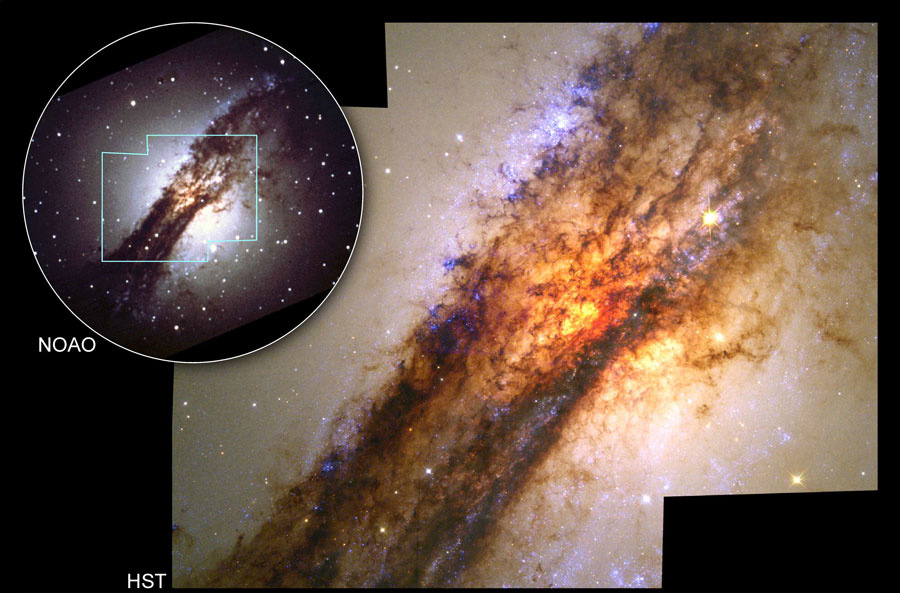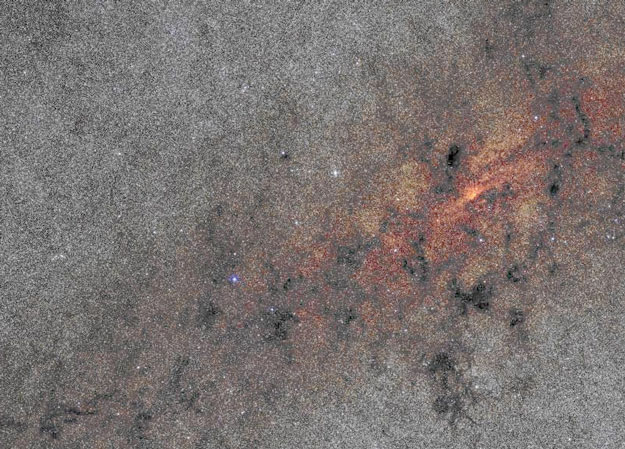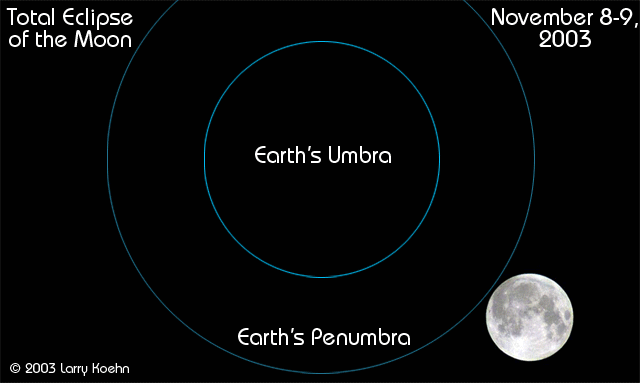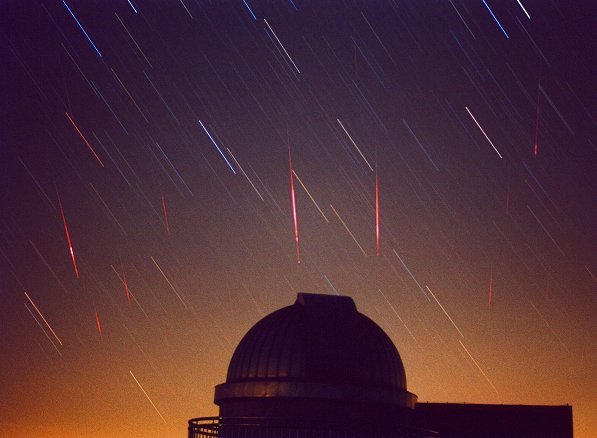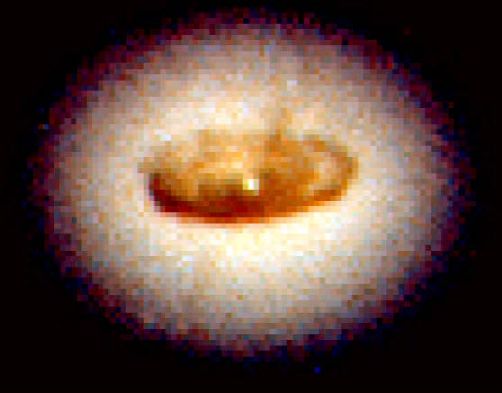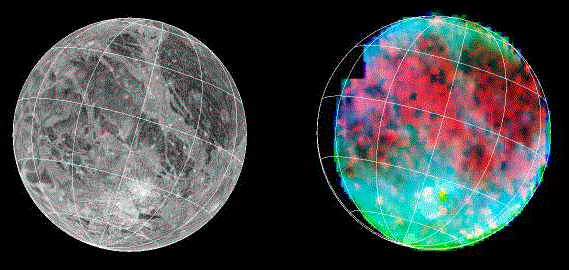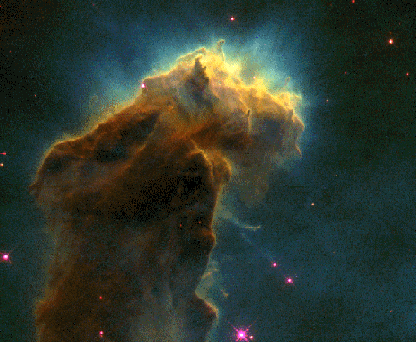| << Previous | Index | Next >> |
2014 This cylindrical projection global map is one of six new color maps of Saturn's midsized icy moons, constructed using 10 years of image data from the Cassini spacecraft. Discovered by Cassini (the astronomer) in 1684, Dione is about 1,120 kilometers across. Based on data extending from infrared to ultraviolet, the full resolution of this latest space-age map is 250 meters per pixel. The remarkable brightness difference between the tidally locked moon's lighter leading hemisphere (right) and darker trailing hemisphere clearly stands out. Like other Saturn moons orbiting within the broad E-ring, Dione's leading hemisphere is kept shiny as it picks up a coating of the faint ring's icy material. The E-ring material is constantly replenished by geysers on moon Enceladus' south pole. Lighter, younger surface fractures also appear to cross the dark, cratered trailing hemisphere.
2013 Timing was critical to catch this image of November 3rd's solar eclipse. But flying at 44,000 feet, intrepid eclipse chasers on a chartered jet traveling 500 miles per hour managed to intercept the the Moon's shadow. The remarkable flight made a perpendicular crossing of the central shadow track. Darkening the skies beyond the wing tip at that moment, the Moon's shadow was moving at some 8,000 miles per hour across the Atlantic Ocean, 600 miles southeast of Bermuda. After only an instant of totality, this snapshot captured the lunar disk in silhouette. Rays of sunlight shining past peaks and valleys along the lunar limb created the fleeting appearance of a glistening diamond ring.
2012
Click to play embedded YouTube video.
Image Credit: NASA, NOAA, GOES-13 Satellite
2011 Massive star IRS 4 is beginning to spread its wings. Born only about 100,000 years ago, material streaming out from this newborn star has formed the nebula dubbed Sharpless 2-106 Nebula (S106), pictured above. A large disk of dust and gas orbiting Infrared Source 4 (IRS 4), visible in dark red near the image center, gives the nebula an hourglass or butterfly shape. S106 gas near IRS 4 acts as an emission nebula as it emits light after being ionized, while dust far from IRS 4 reflects light from the central star and so acts as a reflection nebula. Detailed inspection of images like the above image has revealed hundreds of low-mass brown dwarf stars lurking in the nebula's gas. S106 spans about 2 light-years and lies about 2000 light-years away toward the constellation of the Swan (Cygnus).
2010 A fantastic jumble of young blue star clusters, gigantic glowing gas clouds, and imposing dark dust lanes surrounds the central region of the active galaxy Centaurus A. This mosaic of Hubble Space Telescope images taken in blue, green, and red light has been processed to present a natural color picture of this cosmic maelstrom. Infrared images from the Hubble have also shown that hidden at the center of this activity are what seem to be disks of matter spiraling into a black hole with a billion times the mass of the Sun! Centaurus A itself is apparently the result of a collision of two galaxies and the left over debris is steadily being consumed by the black hole. Astronomers believe that such black hole central engines generate the radio, X-ray, and gamma-ray energy radiated by Centaurus A and other active galaxies. But for an active galaxy Centaurus A is close, a mere 10 million light-years away, and is a relatively convenient laboratory for exploring these powerful sources of energy.
2009 Stickney Crater, the largest crater on the martian moon Phobos, is named for Chloe Angeline Stickney Hall, mathematician and wife of astronomer Asaph Hall. Asaph Hall discovered both the Red Planet's moons in 1877. Over 9 kilometers across, Stickney is nearly half the diameter of Phobos itself, so large that the impact that blasted out the crater likely came close to shattering the tiny moon. This stunning, enhanced-color image of Stickney and surroundings was recorded by the HiRISE camera onboard the Mars Reconnaissance Orbiter as it passed within some six thousand kilometers of Phobos in March of 2008. Even though the surface gravity of asteroid-like Phobos is less than 1/1000th Earth's gravity, streaks suggest loose material has slid down inside the crater walls over time. Light bluish regions near the crater's rim could indicate a relatively freshly exposed surface. The origin of the curious grooves along the surface is mysterious but may be related to the crater-forming impact.
2008 In this colorful mosaic, filaments of gas and dust span some 9 degrees across central Cygnus, a nebula rich constellation along the northern Milky Way. A trio of nebulae with popular names highlights the beautiful skyscape - the Butterfly, the Crescent, and the Tulip. At left, the Butterfly Nebula (IC 1318), lies near bright star Gamma Cygni. The Butterfly's expansive, glowing, wing-shaped gas clouds are divided by a dark dust lane. Near center, the Crescent Nebula (NGC 6888) is more compact, a cosmic bubble with a bright edge blown by winds from a massive Wolf-Rayet star. On the right is the Tulip Nebula (Sh2-101), a small emission region shaped like a blossoming flower viewed from the side. All are within a few thousand light-years of the Sun in the Orion spiral arm of our galaxy. The gorgeous mosaic is presented in false color, constructed from image data recorded through narrow band filters. The range of colors was created by a mapping of emission from hydrogen, sulfur and oxygen atoms in the nebula to red, green, and blue hues.
2007 What is the largest structure known? The answer might depend on how one defines "structure." A grouping of galaxies known as the Sloan Great Wall was discovered in the Sloan Digital Sky Survey and is a leading candidate. The Sloan Great Wall can be seen in this digitally recast contour map of galaxies in the Two Degree Field galaxy survey. Galaxies within one billion light years, a redshift of about 0.1, are depicted. The labeled Sloan Great Wall spans over one billion light years, longer than any structure ever measured. Critics worry that the Sloan Great Wall should not itself be characterized as a coherent structure because it is not currently gravitationally bound together and parts of it might never become gravitationally bound. Regardless, the beauty of the local universe of galaxies is evident in the image where several huge superclusters of galaxies -- clusters of galaxy clusters -- can also be seen. These include the Shapley Supercluster of galaxies, part of the Pisces-Cetus Supercluster, and part of the Horologium-Reticulum Supercluster.
2006 Janus is one of the stranger moons of Saturn. First, Janus travels in an unusual orbit around Saturn where it periodically trades places with its sister moon Epimetheus, which typically orbits about 50 kilometers away. Janus, although slightly larger than Epimetheus, is potato-shaped and has a largest diameter of about 190 kilometers. Next, Janus is covered with large craters but strangely appears to lack small craters. One possible reason for this is a fine dust that might cover the small moon, a surface also hypothesized for Pandora and Telesto. Pictured above, Janus was captured in front of the cloud tops of Saturn in late September.
2005 It's the bubble versus the cloud. NGC 7635, the Bubble Nebula, is being pushed out by the stellar wind of massive central star BD+602522. Next door, though, lives a giant molecular cloud, visible above to the lower right. At this place in space, an irresistible force meets an immovable object in an interesting way. The cloud is able to contain the expansion of the bubble gas, but gets blasted by the hot radiation from the bubble's central star. The radiation heats up dense regions of the molecular cloud causing it to glow. The Bubble Nebula, pictured above in scientifically mapped colors to bring up contrast, is about 10 light-years across and part of a much larger complex of stars and shells. The Bubble Nebula can be seen with a small telescope towards the constellation of Cassiopeia.
2004 The center of our Galaxy is a busy place. In visible light, much of the Galactic Center is obscured by opaque dust. In infrared light, however, dust glows more and obscures less, allowing nearly one million stars to be recorded in the above photograph. The Galactic Center itself appears on the right and is located about 30,000 light years away towards the constellation of Sagittarius. The Galactic Plane of our Milky Way Galaxy, the plane in which the Sun orbits, is identifiable by the dark diagonal dust lane. The absorbing dust grains are created in the atmospheres of cool red-giant stars and grow in molecular clouds. The region directly surrounding the Galactic Center glows brightly in radio and high-energy radiation, and is thought to house a large black hole.
2003 The Moon slides through the Earth's shadow this Saturday night / Sunday morning (November 8/9) giving skygazers in the Americas, Europe, Africa, and western Asia a chance to enjoy a total lunar eclipse. As lunar eclipses go, this will be a brief one though, with the total phase lasting only about 25 minutes. The orientation and relative size of the Earth's shadow and the Moon's trajectory are illustrated in this thoughtful animation showing the full Moon moving up from the lower right, entering the penumbra or outer portion of the shadow region, and then passing well below the center of the darker inner shadow region or umbra. The total eclipse phase begins at 1:06 Universal Time, November 9 (8:06pm EST Nov. 8) when the Moon is completely within the umbra. While the off-center passage guarantees a short total phase, it also makes it likely that this November's eclipsed Moon will be dramatically visible and colorful with a brighter rim along the southern edge.
2002 The 2001 Leonid storm was so intense that the meteor shower's radiant, the point on the sky from which the fleeting trails seemed to diverge, was easy to spot. But the bits of debris that created the meteors really moved along parallel paths, following the orbit of their parent comet Tempel-Tuttle. Their apparent divergence from the shower's radiant point was simply due to perspective as skygazers looked toward the stream of cosmic debris. During the 2001 Leonid storm, while the radiant was above the horizon from SoBaekSan Observatory in South Korea, astronomer Christophe Marlot made this single time exposure recording star trail arcs and a number of meteors. Since Marlot was looking away from the cosmic debris stream, this perspective actually shows red tinged meteor trails converging toward a point below the horizon and opposite the radiant -- the Leonid shower's antiradiant.
2001 Sometimes the unknown is beautiful. In 2000 February near Lake Tahoe, Nevada, two amateur photographers noticed an unusual red column of light rise mysteriously from a setting sun. During the next few minutes, they were able to capture the pillar and a photogenic sunset on film. Pictured above, the red column is seen above a serene Lake Tahoe and snow-capped mountains across from Lake Tahoe-Nevada State Park. The mysterious column, they learned later, is a Sun Pillar, a phenomenon where sunlight reflects off of distant falling ice crystals.
2000 Because the Gum Nebula is the closest supernova remnant, it is actually hard to see. Spanning 40 degrees across the sky, the nebula is so large and faint it is easily lost in the din of a bright and complex background. The Gum Nebula, highlighted nicely in the above wide angle photograph, is so close that we are much nearer the front edge than the back edge, each measuring 450 and 1500 light years respectively. The complex nebula lies in the direction of the constellations of Puppis and Vela. Oddly, much remains unknown about the Gum Nebula, including the timing and even number of supernova explosions that formed it.
1999 Who knows what evil lurks in the hearts of galaxies? The Hubble knows. This Hubble Space Telescope picture of the center of the nearby elliptical galaxy NGC 4261 tells one dramatic tale. The gas and dust in this disk are swirling into what is almost certainly a massive black hole. The disk is probably what remains of a smaller galaxy that fell in hundreds of millions of years ago. Collisions like this may be a common way of creating such active galactic nuclei as quasars. Strangely, the center of this fiery whirlpool is offset from the exact center of the galaxy - for a reason that for now remains an astronomical mystery.
1998 Stars come in bunches. Of the over 200 globular star clusters that orbit the center of our Milky Way Galaxy, 47 Tucanae is the second brightest globular cluster (behind Omega Centauri). Known to some affectionately as 47 Tuc or NGC 104, it is only visible from the Southern Hemisphere. Light takes about 20,000 years to reach us from 47 Tuc which can be seen near the SMC in the constellation of Tucana. Red Giant stars are particularly easy to see in this picture. The dynamics of stars near the center of 47 Tuc are not well understood, particularly why there are so few binary systems there.
1997 Gravity can do more than floor you. According to recent measurements of a star system thought to contain a black hole, it can spin you too. This effect, called frame-dragging, is most prominent near massive, fast spinning objects. Now, a team led by W. Cui (MIT) has used the orbiting Rossi X-ray Timing Explorer to search for it near a system thought to contain a black hole. Cui's team claim that matter in this system gets caught up and spun around the black hole at just the rate expected from frame-dragging. Such discoveries help scientists better understand gravity itself.
1996 What treasures lie on the surface of Ganymede? Last week, NASA released a map of Jupiter's largest moon made by the Galileo Orbiter highlighting ice and minerals deposits. The leftmost photograph by Voyager shows surface features in visible light, but the rightmost photograph, taken in infrared light by Galileo, shows the locations of minerals in red and ice grains in blue. The NIMS team is working to identify these minerals with preliminary hopes of finding emission indicative of montmorillonite and alunite.
1995 Star forming regions known as "EGGs" are uncovered at the end of this giant pillar of gas and dust in the Eagle Nebula (M16). EGGs, short for evaporating gaseous globules, are dense regions of mostly molecular hydrogen gas that fragment and gravitationally collapse to form stars. Light from the hottest and brightest of these new stars heats the end of the pillar and causes further evaporation of gas - revealing yet more EGGs and more young stars. This picture was taken by the Wide Field and Planetary Camera on board the Hubble Space Telescope.
| << Previous | Index | Next >> |
